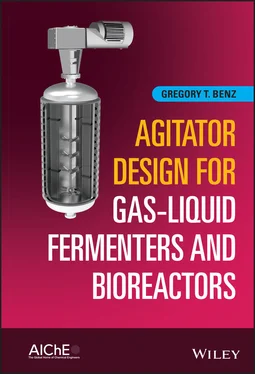5 Chapter 8Table 8.1 Designing with no data.Table 8.2 Sample P/V, VVM scale‐up.Table 8.3 DO ratio guidelines.
6 Chapter 9Table 9.1 OTR profile.Table 9.2 Power at different operating scenarios.
7 Chapter 10Table 10.1 Typical fouling resistances.Table 10.2 K values for helical coils.Table 10.3 Recommended minimum tubing diameters for tube bundles.Table 10.4 K values for tube bundles.Table 10.5 K values for plate coil baffles.Table 10.6 Thermal properties of water.Table 10.7 Thermal conductivities of common vessel materials.
8 Chapter 11Table 11.1 Diffusion coefficients of different gases in water.Table 11.2 Relative k la values.Table 11.3 Solubility of some gases in water.
9 Chapter 12Table 12.1 Metzner–Otto constants for impellers.Table 12.2 Rheological properties of Xanthan Gum.Table 12.3 Rheological properties of 2% Gellan Gum solutions.Table 12.4 Xanthan Gum installation data.Table 12.5 D/T guidelines for pseudoplastic fluids.Table 12.6 Z/T per impeller guidelines in gas/liquid systems.
10 Chapter 14Table 14.1 Relative blend time.
11 Chapter 15Table 15.1 Seal comparisons.
12 Chapter 16Table 16.1 Agitator nozzle and pad mount reinforcement dimensions (typical).Table 16.2 Vessel head and reinforcing pad thickness, mm.
13 Chapter 17Table 17.1 Dimensionless hydraulic forces.Table 17.2 Allowable stresses.Table 17.3 Critical speed guidelines.Table 17.4 Deep concave turbine weights.Table 17.5 High solidity axial turbine weights.Table 17.6 Dynamic analysis inputs.Table 17.7 AGMA bearing life requirement.Table 17.8 Recommended gear drive service factors.Table 17.9 Gear drive comparison.
14 Chapter 18Table 18.1 Surface finishes.
15 Chapter 19Table 19.1 Vessel dimensions.Table 19.2 Optimum power summary.Table 19.3 Heat transfer results.Table 19.4 Capital costs.Table 19.5 Problem 2 optimum power requirements.Table 19.6 Problem 2 heat transfer results.Table 19.7 Problem 2 Capex summary.Table 19.8 Optimum power at 75 OTR, problem 3.Table 19.9 Problem 3 heat transfer results.Table 19.10 Problem 3 alt 1 heat transfer results.Table 19.11 Capex based on chilled water, problem 3.Table 19.12 Capex based on cooling tower water, problem 3.
16 Chapter 20Table 20.1 Supplier Audit Checklist
1 Chapter 2 Figure 2.1 Agitator design flow chart.
2 Chapter 3 Figure 3.1 Agitated tank. Figure 3.2 Agitated tank sketch. Figure 3.3 Swept diameter. Figure 3.4 Typical power number curve. Figure 3.5 Typical pumping number curve. Figure 3.6 Dimensionless blend time. Figure 3.7 Gassing factors. Figure 3.8 shear stress curve. Figure 3.9 viscosity curve.
3 Chapter 4 Figure 4.1 Flooding determination by using k la. Figure 4.2 Impeller flooding by power draw. Figure 4.3 Visual flooding. Figure 4.4 Available motor power curve using VFD.
4 Chapter 5 Figure 5.1 Axial flow pattern. Figure 5.2 Solidity. Figure 5.3 Radial flow pattern. Figure 5.4 Mixed flow pattern. Figure 5.5 (a) Proquip HFI.(b) Chemineer XE‐3. Figure 5.6 (a) Fusion Fluid PF3.(b) Lightnin A510E22/A‐310.(c) Chemi... Figure 5.7 Chemineer SC‐3. Figure 5.8 (a) Chemineer Maxflo W.(b) Chemineer Maxflo Y up‐pumping.... Figure 5.9 Axial flow gassing factors at D/T ~ 0.4. Figure 5.10 Straight blade turbine by Chemineer. Figure 5.11 Rushton turbine. Figure 5.12 Rushton gas cavities. Figure 5.13 Gas pocket photo. Figure 5.14 Rushton turbine gassing factors. Figure 5.15 Chemineer CD‐6 impeller. Figure 5.16 CD‐6 gas pockets. Figure 5.17 CD‐6 gassing factors. Figure 5.18 (a) ICI Patent drawing.(b) SCABA 6SRGT.(c) Lightnin R‐13... Figure 5.19 BT‐6 impeller. Figure 5.20 BT‐6 no gas pockets. Figure 5.21 BT‐6 gassing factors. Figure 5.22 BT‐6 vs. Phasejet gassing factors. Figure 5.23 BT‐6 gas dispersion data. Figure 5.24 Blade struts. Figure 5.25 Pitched‐blade turbine. Figure 5.26 (a) Ekato Intermig patent drawing. (b) ProQuip Doubly Pitched im...Figure 5.27 Chemineer JT‐2.Figure 5.28 Torus zones.Figure 5.29 Ekato Combijet patent drawing.
5 Chapter 6Figure 6.1 Multiple radial flow pattern.Figure 6.2 Axial–radial flow pattern.Figure 6.3 Gas flow profile.Figure 6.4 Power draw profile.Figure 6.5 k la profile.Figure 6.6 Example graphic comparison of power draw.Figure 6.7 Example graphic comparison of k la.Figure 6.8 Ring sparger.Figure 6.9 Pie‐plate sparger.Figure 6.10 Fine bubble diffusers.
6 Chapter 7Figure 7.1 Power optimization curve.Figure 7.2 Comparing correlations.Figure 7.3 Dynamic k la method.
7 Chapter 8Figure 8.1 Optimum power.
8 Chapter 9Figure 9.1 OTR profile graphed.Figure 9.2 Total power graphically.
9 Chapter 10Figure 10.1 (a and b) Helical coil plus simple jacket, plan, and elevation v...Figure 10.2 (a and b) Vertical tube bundles plus dimple jacket, plan, and el...Figure 10.3 (a and b) Small helical coils plus half‐pipe jacket, plan, and e...Figure 10.4 (a and b) Plate coils used as baffles, plan, and elevation views...Figure 10.5 Dimple jacket cross section.Figure 10.6 Effect of baffle number on Power Draw.
10 Chapter 12Figure 12.1 Cavern visualization, permission of Wiley Interscience.Figure 12.2 Cavern segregation, permission of Wiley Interscience.Figure 12.3 Xanthan Gum installations.Figure 12.4 (a–e) Low D/T results.Figure 12.5 (a–e) Large D/T results.Figure 12.6 Hypothetical Xanthan Gum production curve.
11 Chapter 13Figure 13.1 Effect of palm oil on xanthan k la.
12 Chapter 14Figure 14.1 BT‐6 grid.Figure 14.2 Tank grid.Figure 14.3 Vector velocity plot.Figure 14.4 Raster velocity plot.Figure 14.5 Cavern raster plot.Figure 14.6 Cavern surface plot.Figure 14.7 (a–d) blending progress at 0, 4, 10, and 20 s.Figure 14.8 Coil layout.Figure 14.9 Velocities around coils.Figure 14.10 Volume fraction, etc.Figure 14.11 DO distribution.
13 Chapter 15Figure 15.1 Agitator with seal.Figure 15.2 Shaft entry position.Figure 15.3 Radial lip seal.Figure 15.4 Axial lip seal.Figure 15.5 Compression packing.Figure 15.6 (a) Cartridge single mechanical seal with bearing.(b) single...Figure 15.7 Dry‐running contacting single seal.Figure 15.8 Fully split single mechanical seal.Figure 15.9 Double mechanical seal.Figure 15.10 Gas lubricated seal.Figure 15.11 Pressure gradient.Figure 15.12 Gas control panel.Figure 15.13 Debris catcher.Figure 15.14 Magnetic drive.Figure 15.15 API plan 32.Figure 15.16 API Plan 53A.Figure 15.17 (a) API Plan 74.(b) API Plan 74 gas panel.
14 Chapter 16Figure 16.1 Direct nozzle mount unit.Figure 16.2 Agitator/vessel FEA.Figure 16.3 Mounting nozzle details.Figure 16.4 Right‐angle mount with auxiliary motor support.Figure 16.5 Vertical motor mount.Figure 16.6 Auxiliary stuffing box or lip seal.Figure 16.7 Auxiliary mechanical seal sidewall beams.Figure 16.8 Auxiliary mechanical seal beams to building.Figure 16.9 Bellows connector, beams to sidewall.Figure 16.10 Bellows connector, beams to building.Figure 16.11 Direct nozzle mount bottom entering unit.Figure 16.12 Floor mount with auxiliary packing.Figure 16.13 Floor mount with auxiliary mechanical seal.Figure 16.14 Floor mount with bellows connector.
15 Chapter 17Figure 17.1 Cantilevered load diagram.Figure 17.2 Steady bearing load diagram.Figure 17.3 Critical speed model.Figure 17.4 Steady bearing dynamic analysis.Figure 17.5 Steady bearing dynamic analysis example output with hollow shaft...Figure 17.6 Commercial gear drive design load diagram.Figure 17.7 Agitator load diagram.Figure 17.8 (a, b) Commercial gear drive size comparison.Figure 17.9 Purpose‐built solid shaft agitator drive.Figure 17.10 Hollow quill agitator drive.Figure 17.11 Outboard support module.
16 Chapter 18Figure 18.1 Welded in‐tank coupling.Figure 18.2 Removable in‐tank coupling, taper bore style.Figure 18.3 Sterilizable coupling.Figure 18.4 Sanitary in‐tank coupling.Figure 18.5 Internally threaded shaft coupling.Figure 18.6 Standard mounting flange modification.Figure 18.7 Sanitary mounting flange.Figure 18.8 Lightnin A‐315.Figure 18.9 Chemineer Maxflo W‐4.Figure 18.10 Smoothline impeller.Figure 18.11 Rushton turbine.Figure 18.12 Chemineer CD‐6.Figure 18.13 Chemineer BT‐6.Figure 18.14 Acorn nut.Figure 18.15 Tripod steady bearing.Figure 18.16 Sterilizable steady bearing.Figure 18.17 Polished surface.Figure 18.18 Burnished surface.Figure 18.19 Unidirectional lay.Figure 18.20 Random lay.Figure 18.21 Fine vs. coarse abrasive with same RA.Figure 18.22 Electropolish process.
Читать дальше












